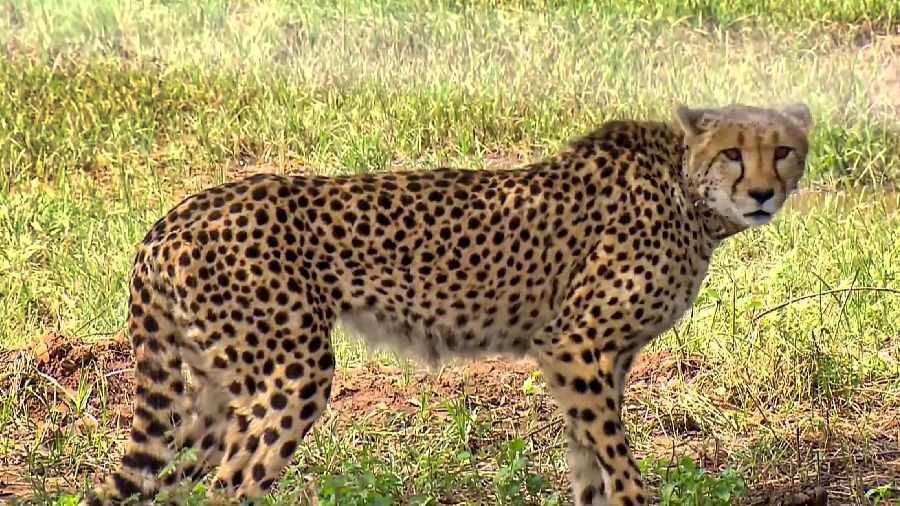Three male cheetahs will occupy the entire Kuno National Park in Madhya Pradesh and not leave space for any more territorial males, who will therefore come into conflict with local livestock farmers, three wildlife biologists have predicted.
The scientists, from the Leibniz Institute of Zoo and Wildlife Research in Berlin, have suggested that India’s cheetah introduction project may have disregarded the animals’ unique behavioural “spatial tactics”, which challenge assumptions that Kuno has sufficient prey to support up to 21 cheetahs.
Bettina Wachter, an evolutionary ecologist at the Institute who has studied African cheetahs for over two decades, and her colleagues have said that male cheetahs tend to be territorial and occupy distinct territories separated by about 20-23km.
India brought eight cheetahs — three males and five females — from Namibia in September 2022 to Kuno, a key step in a project that seeks to establish wild cheetah populations in protected areas. Kuno received 12 more cheetahs from South Africa in February this year.
Project managers have released three Namibian cheetahs into the open wild in Kuno, while the others remain in fenced enclosures. A Namibian female cheetah died last month from kidney failure, which some scientists say may have been an outcome of long captivity.
Another Namibian cheetah gave birth to four cubs last month after mating with a Namibian male.
The Union environment ministry’s cheetah introduction project document says Kuno has sufficient prey to accommodate up to 21 cheetahs. Project scientists have said an abundance of prey would allow that number of cheetahs to coexist within Kuno’s boundaries.
But Wachter and her colleagues said the three males from Namibia would each establish a territory separated by 20km to 23km. This, they have predicted, will not leave any space for any more territorial cheetahs in Kuno, which measures about 17km by 44km.
“What we see with cheetahs is that irrespective of the prey availability, the distance between their territories is always between 20 and 23 kilometres,” Wachter told The Telegraph. “This is possibly an inherent behavioural trait.”
Wachter and her colleagues have observed such a separation in two different ecosystems — in Namibia, marked by farmland, livestock and resident prey, and in Tanzania, marked by protected areas, the absence of people, and migratory prey.
“It is striking to see that the territories have the same separation distance in both ecosystems,” she said.
Wachter and her colleagues Ruben Portas and Joerg Melzheimer have used their observations in Africa to predict what they expect will happen in India. They published their predictions earlier this week in the research journal Conservation Science and Practice.
They have also predicted that the cheetahs from Namibia would conduct extensive excursions during the early exploratory phase of their release in the open wild. One of the Namibian cheetahs has already ventured outside Kuno’s boundaries, approaching villages a few times earlier this month.
Such exploratory excursions can give rise to conflict with local livestock farmers.
Any additional males introduced or born in Kuno will establish their own territories away from the first three cheetahs, and thus also likely move into human-dominated spaces, the scientists have said.
A query sent by this newspaper to the Union environment ministry seeking a response to the concerns expressed by Wachter and her co-authors has not brought a response. A scientist involved in the project told this reporter to read the cheetah introduction plan, which says Kuno can accommodate 21 cheetahs.
Wachter and her colleagues are “among the best in the business on cheetah behaviour”, said Arjun Gopalaswamy, a statistical ecologist in Bangalore who too had cautioned last year that Kuno would not be able to hold 21 cheetahs.
“We had used broad arguments of cheetah density and the space available,” Gopalaswamy said. “Now Wachter and her co-workers have described the (behavioural) mechanisms that explain why space is short.”
Wachter said the only way Kuno could support 21 cheetahs was if the entire park was fenced. “Without the fence, we predict that the cheetahs will distribute themselves in the same way they do in Namibia and Tanzania. This means the cheetahs will walk out and approach villages,” she said.
“It is therefore likely that this will result in conflicts with livestock farmers.”
She said the only way to reduce the conflict was to protect the livestock. “This is what farmers are doing in Namibia. But to shift cattle, calves or smaller livestock at least 5km away from the core area, a lot of land would be needed,” she said.
“Alternatively, the livestock needs to be herded by a person during the day who can chase away an approaching cheetah.”
Some Indian wildlife scientists have sought an additional site for the cheetahs. A candidate site named Mukundara in Rajasthan is near-ready but the Centre has not yet approved the introduction of cheetahs there.
Cheetah dead
One of the cheetahs flown into Kuno in February died on Sunday within its fenced enclosure, wildlife authorities managing India’s cheetah introduction project said. The six-year-old named Uday was among 12 wild cheetahs brought in from South Africa. This is the second cheetah death in Kuno, after a Namibian cheetah named Sasha died on March 27.











